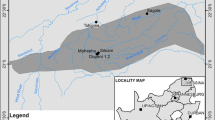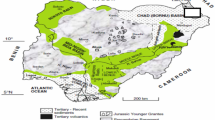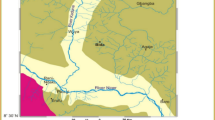Abstract
The study presents the results of the analyses of heat flow for geothermal energy exploration on a reconnaissance basis within the Bornu Basin and its environs using an airborne magnetic and radiometric data set. The study area is bounded with latitude 11.00–13.00°N and longitude 11.00–14.00°E with an estimated total area of 72,600 km2. The residual of the total magnetic field of the study area was subdivided into seventy-one (71) overlapping spectral blocks of 55 × 55 and 110 × 110 km2 windows. Spectral analysis by fast Fourier transform was performed on each overlapping block, and centroid depth and depth to the top of the magnetic source were obtained from the plots of the log of energy against wave number. The results showed that the centroid depth for the two windows ranges from 6.28 to 17.70 km and 7.83 km to 23.50 km, respectively. Similarly, the depth to the top of the magnetic source for the two windows also ranges from 1.66 to 6.12 km and 2.27 km to 6.37 km. The Curie point depth obtained for the two windows ranges from 8.78 to 32.69 km and 10 km to 42 km, respectively. The heat flow obtained using an average thermal conductivity of 2.54 Wm−1°C−1 ranges from 55.36 to 161.18 mWm−2 and 34.30 to 126 mWm−2 for the two windows, respectively. The maximum heat flow of 80 to 100 mWm−2 indicates that a geothermal potential source was found at the southeastern part of the study area corresponding to Gwoza and Galdekore. The results of radiogenic heat flow (RHP) range from 0.80 to 2.47 μWm−3. The maximum RHP of 2.2 to approximately 2.5 μWm−3 is considered as radiometric signatures signifying probable geothermal potential sources, which could be found at the southeastern part of the study area corresponding to Gwoza and Galdekore. The agreement between the two heat flows obtained from the analysis of airborne magnetic and radiometric data sets is an indicator that the southeastern part of the study area is a viable source for potential geothermal energy exploration.









Similar content being viewed by others
References
Abraham EM, Lawal KM, Ekwe AC, Alile O, Murana KA, Lawal AA (2014) Spectral analysis of aeromagnetic data for geothermal energy investigation of Ikogosi Warm Spring-Ekiti State, southwestern Nigeria. Geothermal Energy 2(1):6
Ademila O, Okpoli CC, Ehinmitan D, (2019) Geological and lithological mapping of part of Igarra schist belt using integrated geophysical methods. Earth Sciences Pakistan (ESP), Zibeline International Publishing, vol. 3(1), pages 1-9
Ademila O (2018) Integrated geophysical methods for subsurface characterisation and health hazard assessment in parts of southwestern basement Nigeria. 2nd International Conference on Science and Sustainable Development, IOP Conf. Series: Earth and Environmental Science. https://doi.org/10.1088/1755-1315/173/1/012024
Adepelumi AA, Falade AH (2017) Combined high-resolution aeromagnetic and radiometric mapping of uranium mineralization and tectonic settings in Northeastern Nigeria. Acta Geophysica 65(5):1043–1068
Aderoju AB, Ojo SB, Adepelumi AA, Edino F (2016) A reassessment of hydrocarbon prospectivity of the Chad Basin, Nigeria, using magnetic hydrocarbon indicators from high resolution aeromagnetic imaging, Ife J Sci 18(2)
Airo ML (2007) Application of aerogeophysical data for gold exploration: implications for the Central Lapland greenstone belt. Geol Surv Finland Spec Pap 44:187–208
Akiishi M, Isikwue BC, Tyovenda AA (2018) Determination of geothermal energy sources in Masu area northeastern Nigeria using spectral analysis of aeromagnetic data. Int J Energy Environ Sci 3(5):89
Alistair TM, Thomas LH, Paul LY, David CW, Alan JC (2014) Gamma-ray spectrometry in geothermal exploration: state of the art techniques. Energies 2014(7):4757–4780. https://doi.org/10.3390/en7084757
Anderson H, Nash C (1997) Integrated lithostructural mapping of the Rössing area, Namibia using high resolution aeromagnetic, radiometric, Landsat data and aerial photographs. Explor Geophys 28(2):185–191
Appiah D (2015) Aeromagnetic and airborne radiometric data interpretation on Chirano area of the Sefwi gold belt, Department of Physics, Kwane Nkrumah University of Science and Technology. (M.Sc. dissertation)
Bansal AR, Dimri VP (2010) Scaling spectral analysis: a new tool for interpretation of gravity and magnetic data. e-J Earth Sci India 3(1):54–68
Bansal AR, Gabriel G, Dimri VP, Krawczyk CM (2011) Estimation of depth to the bottom of magnetic sources by a modified centroid method for fractal distribution of sources: an application to aeromagnetic data in Germany. Geophysics 76(3):L11–L22
Bassey NE, Barka J (2015) Lithologic and structural mapping using aeromagnetic and ground radiometric data in Song area, NE Nigeria. J Geogr Environ Earth Sci Int 2(4):173–179
Bektaş Ö, Ravat D, Büyüksaraç A, Bilim F, Ateş A (2007) Regional geothermal characterisation of East Anatolia from aeromagnetic, heat flow and gravity data. Pure Appl Geophys 164(5):975–998
Benkhelil J (1989) The origin and evolution of the Cretaceous Benue Trough (Nigeria). J Afr Earth Sci (and the Middle East) 8(2-4):251–282
Bhattacharyya BK, Leu LK (1975) Analysis of magnetic anomalies over Yellowstone National Park: mapping of Curie point isothermal surface for geothermal reconnaissance. J Geophys Res 80:4461–4465
Bhattacharyya BK, Leu LK (1977) Spectral analysis of gravity and magnetic anomalies due to rectangular prismatic bodies. Geophysics 42:41–50
Bird DE (1997) Primer: interpreting magnetic data. Am Assoc Pet Geol Explorer 8(5):18–21
Blakeley RJ (1988) Curie temperature isotherm analysis and tectonic implications of aeromagnetic data from Nevada. J Geophys Res 93:817–832
Blakely RJ (1995) Potential theory in gravity and magnetic applications. Cambridge University Press, Cambridge
Čermák V, Rybach L (1982) Thermal conductivity and specific heat of minerals and rocks. In: G Angenheister (ed.), Landolt-Börnstein: numerical data and functional relationships in science and technology, new series, Group V (Geophysics and Space Research), vol Ia, (Physical Properties of Rocks) (pp. 305-343). Springer, Berlin-Heidelberg
Connard G, Couch R, Gemperle M (1983) Analysis of aeromagnetic measurements from the Cascade Range in central Oregon. Geophysics 48(3):376–390
Dieokuma T, Gu HM, Uko ED (2013) Preliminary estimation of thermal conductivity in Bornu-Chad Basin, Nigeria. Eur Sci J 9(30)
Dimgba BC, Obiora DN, Abangwu JU, Ugbor DO (2020) Study of Curie point depth and heat flow from spectral analysis of aeromagnetic data for geothermal potential of Gubio, Chad Basin, Nigeria. SN Appl Sci 2(8):1–9
Ejepu JS, Ako TA, Abdullahi S (2018) Integrated geosciences prospecting for gold mineralization in Kwakuti, North-Central Nigeria. J Geol Min Res 10(7):81–94
Elkhateeb SO, Abdellatif AG (2018) Delineation potential gold mineralisation zones in part of central Eastern Desert, Egypt using airborne magnetic and radiometric data. NRIAG J Astron Geophys 7(2):361–376
Ercan ÖA, Şeren A, Elmas A (2014) Gold and silver prospection using magnetic, radiometry and microgravity methods in the Kışladağ Province of Western Turkey. Resour Geol 64(1):25–34
Eze MO, Mamah LI, Madu AJC, Onuba L (2017) Geological and structural interpretation of possible mineralization zones of part of Anambra Basin and southern Benue trough using airborne geophysical data. Int J Res Eng Appl Sci (IJREAS) Issues 5(7):70–80
Goossens MA (1993) Integrated analysis of Landsat TM, airborne magnetic, and radiometric data, as an exploration tool for granite-related mineralization, Salamanca province, Western Spain. Nonrenew Resour 2(1):14–30
Genik GJ (1992) Regional framework, structural and petroleum aspects of rift basins in Niger, Chad and the Central African Republic (C.A.R.). Tectonophysics 213:169–185
Haack U (1982) Radioactivity of rocks. In: Hellwege K (Ed.), Landolt-Bo¨rnstein numerical data and functional relationships in science and technology. New Series, Group V. Geophysics and Space Research, vol. 1, Physical properties of rocks, supvolume b (pp. 433–481). Springer-Verlag: New York
IAEA (International Atomic Energy Agency) (2003) Guidelines for radioelement mapping using gamma ray spectrometry data, Vienna
Irumhe PE, Obiadi II, Obiadi CM, Ezenwaka CK, Mgbolu CC (2019) Estimating sedimentary pile thickness, structural lineaments and heat flow in parts of North Central Nigeria from aeromagnetic data. Solid Earth Sci 4(3):92–101
Jessop AM, Lewis TJ, Judge AS, Taylor AE, Drury MJ (1984) Terrestrial heat flow in Canada. Tectonophysics 103(1-4):239–261
Joly J (1909) Radioactivity and geology: an account of the influence of radioactive energy on terrestrial history. A. Constable & Company, Limited
Kearey P, Brooks M, Hill I (2002) An introduction to geophysical exploration. Blackwell Science Ltd., London
Kwaya MY, Kurowska E, Arabi AS (2016) Geothermal gradient and heat flow in the Nigeria sector of the Chad Basin, Nigeria. Computational Water Energy Environ Eng 5(02):70
Lawal TO (2020) Integrated aeromagnetic and aeroradiometric data for delineating lithologies, structures, and hydrothermal alteration zones in part of southwestern Nigeria. Arab J Geosci 13(16):1–19
Lawal TO, Nwankwo LI (2017) Evaluation of the depth to the bottom of magnetic sources and heat flow from high resolution aeromagnetic (HRAM) data of part of Nigeria sector of Chad Basin. Arab J Geosci 10(17):1–2
Maden N (2010) Curie-point depth from spectral analysis of magnetic data in Erciyes stratovolcano (Central TURKEY). Pure Appl Geophys 167(3):349–358
Mayhew MA (1982) Application of satellite magnetic anomaly data to Curie isotherm mapping. J Geophys Res 87:4846–4854
Mayhew MA (1985) Curie isotherm surfaces inferred from high-altitude magnetic anomaly data. J Geophys Res 90:2647–2654
NGSA (Nigerian Geological Survey Agency) (2005) Newsletter, volume 2
Nwankwo LI, Shehu AT (2015) Evaluation of Curie-point depths, geothermal gradients and near-surface heat flow from high-resolution aeromagnetic (HRAM) data of the entire Sokoto Basin, Nigeria. J Volcanol Geotherm Res 305:45–55
Nwankwo NC, Anthony AS, Nwosu LI (2009) Estimation of the heat flow variation in the Chad Basin Nigeria. J Appl Sci Environ Manag 13(1)
Nwankwo C, Ekine A (2009) Geothermal gradients in the Chad Basin, Nigeria, from bottom hole temperature logs. Int J Physical Sci 4(12):777–783
Obaje NG (2009) Geology and mineral resources of Nigeria. Lecture Notes in Earth Sciences. Springer, Heidelberg
Okeyode IC, Olurin OT, Ganiyu SA, Olowofela JA (2019) High resolution airborne radiometric and magnetic studies of Ilesha and its environs, southwestern Nigeria. Mater Geoenviron 66(1):51–73
Okosun EA (1992) Cretaceous ostracod biostratigraphy from Chad Basin in Nigeria. J Afr Earth Sci 14(3):327–339
Okosun EA (1995) Review of geology of Bornu Basin. J Min Geol 31(2):113–172
Okpoli C, Akingboye A (2016) Reconstruction and appraisal of Akunu–Akoko area iron ore deposits using geological and magnetic approaches. Mater Geoenviron 63(1):19–38
Okubo Y, Graf RJ, Hansent RO, Ogawa K, Tsu H (1985) Curie point depths of the island of Kyushu and surrounding areas Japan. Geophysics 53:481–494
Okubo Y, Matsunaga T (1994) Curie point depth in northeast Japan and its correlation with regional thermal structure and seismicity. J Geophys Res Solid Earth 99(B11):22363–22371
Okubo Y, Tsu H, Ogawa K (1989) Estimation of Curie point temperature and geothermal structure of island arcs of Japan. Tectonophysics 159(3-4):279–290
Okubo Y, Makino M, Kasuga S (1991) Magnetic model of the subduction zone in the northeast Japan Arc. Tectonophysics 192(1-2):103–115
Okubo Y, Matsushima J, Correia A (2003) Magnetic spectral analysis in Portugal and its adjacent seas. Physics Chem Earth, Parts A/B/C 28(9-11):511–519
Olabode SO, Adekoya JA, Ola PS (2015) Distribution of sedimentary formations in the Bornu Basin, Nigeria. Pet Explor Dev 42(5):674–682
Olugbemiro RO, Ligouis B, Abaa SI (1997) The Cretaceous series in the Chad Basin, NE Nigeria: source rock potential and thermal maturity. J Pet Geol 20:51–68
Paoletti V, Pinto A (2005) Aeromagnetic and radiometric data localized filtering at the Vesuvian volcanic area. Boll Geofis Teor Appl 46(2-3):245–259
Pereira LCL, Santos LC, Carrino TA (2019) The role of airborne geophysics in the investigation of gold occurrences in the Itapetim Region, Borborema Province, Northeast Brazil. Braz J Geol 49(3)
Pollack HN, Chapman DS (1977) On the regional variation of heat flow, geotherms, and lithospheric thickness. Tectonophysics 38(3-4):279–296
Reynolds JM (2011) An introduction to applied and environmental geophysics. John Wiley & Ltd. Bans Lane, Chichester, pp 124–132
Ross HE, Blakely RJ, Zoback MD (2006) Testing the use of aeromagnetic data for the determination of Curie depth in California. Geophysics 71(5):L51–L59
Roque A, Ribeiro FB (1997) Radioactivity and radiogenic heat production in the sediments of the São Francisco sedimentary basin, Central Brazil. Appl Radiat Isot 48(3):413–422
Rybach L, Buntebarth G (1981) Heat-generating radioelements in granitic magmas. J Volcanol Geotherm Res 10(4):395–404
Rybach L (1986) Amount and significance of radioactive heat sources in sediments. In: Thermal Modeling in Sedimentary Basins: 1st IFP Exploration Research Conference, Carcans, France, (Vol. 44, p. 311). Editions Technip
Rybach L (1988) Determination of heat production rate. In: Haenel R, Rybach L, Stegena L (eds) Handbook of Terrestrial Heat-Flow Density Determination. Kluwer Academic Publishers, Dordrecht, pp 125–142
Salem A, Ushijima K, Elsiraft A, Mizunga H (2000) Spectral analysis of aeromagnetic data for geothermal reconnaissance of Quseir area, northern Red Sea, Egypt. Proceedings of the world geothermal congress: 1669-1674
Salem A, Green C, Ravat D, Singh KH, East P, Fairhead JD, Biegert E (2014) Depth to Curie temperature across the central Red Sea from magnetic data using the de-fractal method. Tectonophysics 624:75–86
Shirani S, Kalateh AN, Noorollahi Y (2020) Curie point depth estimations for northwest Iran through spectral analysis of aeromagnetic data for geothermal resources exploration. Nat Resour Res 29(4):2307–2332
Siagian ISJ, Nasution BS, Widijono B, Setyanta A, Nurmaliah MK, Adrian N (2013) Airborne magnetic and radiometric geophysical mapping in South and Central Range Mountains, Papua Indonesia. ASEG Extended Abstracts 2013(1):1–4. https://doi.org/10.1071/ASEG2013ab371
Spector A, Grant FS (1970) Statistical models for interpreting aeromagnetic data. Geophysics 35:293–302
Stampolidis A, Kane I, Tsokas GN, Tsourlos P (2005) Curie point depths of Albania inferred from ground total field magnetic data. Surv Geophys 26(4):461–480
Tanaka A, Okubo Y, Matsubayashi O (1999) Curie point depth based on spectrum analysis of magnetic anomaly data in East and Southeast Asia. Tectonophysics 306:461–470
Tsokas GN, Hansen RO, Fytikas M (1998) Curie point depth of the island of Crete (Greece). Pure Appl Geophys 152(4):747–757
Vacquier V (1998) A theory of the origin of the Earth’s internal heat. Tectonophysics 291(1-4):1–7
Vilà M, Fernández M, Jiménez-Munt I (2010) Radiogenic heat production variability of some common lithological groups and its significance to lithospheric thermal modelling. Tectonophysics 490(3-4):152–164
Funding
The authors appreciated and thanked the management of the Tertiary Education Trust Fund (TETFund) for the provision of fund for this research through the Federal University of Lafia, Nasarawa State, Nigeria.
Author information
Authors and Affiliations
Corresponding author
Ethics declarations
Conflict of interest
The authors declare that they have no competing interests.
Additional information
Responsible Editor: Domenico M. Doronzo
Rights and permissions
About this article
Cite this article
Adewumi, T., Salako, K.A., Usman, A.D. et al. Heat flow analyses over Bornu Basin and its environs, Northeast Nigeria, using airborne magnetic and radiometric data: implication for geothermal energy prospecting. Arab J Geosci 14, 1355 (2021). https://doi.org/10.1007/s12517-021-07370-2
Received:
Accepted:
Published:
DOI: https://doi.org/10.1007/s12517-021-07370-2




